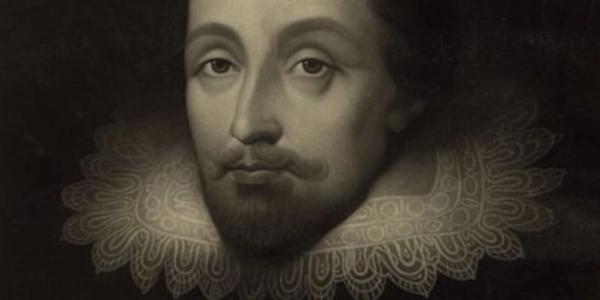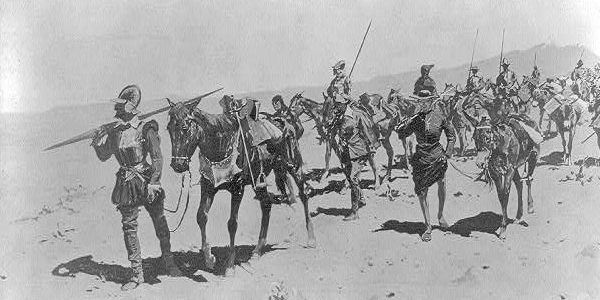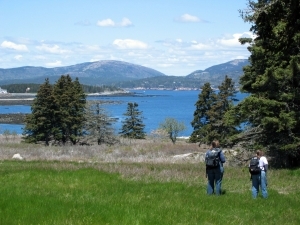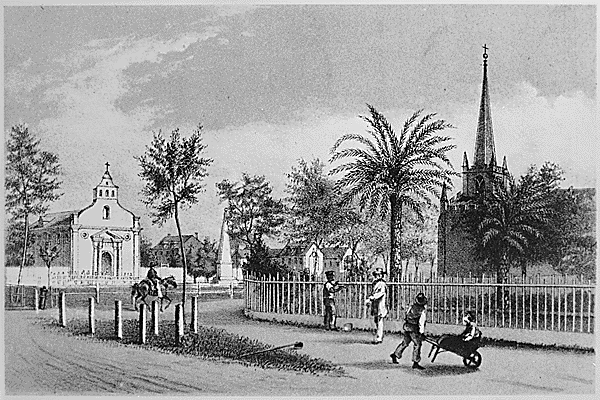Sponsor this page. Your banner or text ad can fill the space above.
Click here to Sponsor the page and how to reserve your ad.
-
Timeline
Detail - 1587
July 27, 1587 - A second try to colonize Roanoke Island is attempted by Sir Walter Raleigh under the governor John White. White came back to England to find more supplies, but his return was delayed due to the need for ships to fight the Spanish Armada.
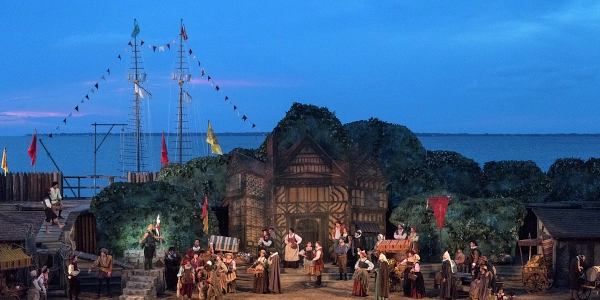
With the first attempt to colonize Roanoke a failure as the colonists returned home with Sir Francis Drake on July 27, 1586, and those few men left by Sir Richard Grenville assumed alive, but soon to be known as dead, Sir Walter Raleigh, named captain of the Queen's personal guard, then promoted to Lord Chancellor on April 29, 1587, made plans to send another group of colonists under John White. Raleigh again wanted to go himself on this fourth voyage; the Queen again would not let him.
White, as Governor, and eleven other men were adorned with titles to run the colony, Assistants/Counsellors of the City of Ralegh in Virginia to be built on the Chesapeake River. One hundred fifty colonists, plus sailors, both men and women, would make the journey on three ships, flagship Lion, a pinnace, and a flyboat, beginning May 8. They brought farming equipment to make the colony self sustaining. White and his colonists arrived on Roanoke Island on July 22, 1587, relieved to see Cape Hatteras. It had been a harrowing journey, particularly when nearing Cape Fear.
List of 1587 Colonists
Arnold Archard, Joyce Archard (wife), Thomas Archard (child)
Henry Berry, Richard Berry
John Chapman, Alis Chapman
Ananias Dare, Eleanor Dare
Dyonis Harvie, Margery Harvie
George How, George How (child)
Henry Johnson, Nicholas Johnson
John Jones, Jane Jones, Griffen Jones
Peter Little, Robert Little
Edward Powell, Wenefrid Powell
Roger Prat, John Prat (child)
John Sampson, John Sampson (child)
Clement Tayler, Hugh Tayler
Ambrose Viccars, Elizabeth Viccars, Ambrose Viccars (son)
John White, Cutbert White
Brian Wyles, John Wyles
Colman (No first name recorded), Elizabeth Glane, Margaret Lawrence, Jane Mannering, Emme Merrimothm, Rose Payne, Jane Pierce, Audry Tappan, Joan Warren, Agnes Wood (Women)
Robert Ellis, Thomas Humfrey, Thomas Smart, William Wythers (children)
Mauris Allen, Richard Arthur, Roger Baily, Marke Bennet, William Berde, Michael Bishop, John Borden, John Bridger, John Bright, John Brooke, William Browne, Henry Browne, John Burden, Thomas Butler, Anthony Cage, John Cheven, William Clement, Thomas Colman, Christopher Cooper, John Cotsmur, Richard Darige, Henry Dorrell, William Dutton, Thomas Ellis, John Earnest, John Farre, Simon Fernandes, Charles Florrie, John Gibbes, Thomas Gramme, John Stilman, John Tydway, Edmond English, Thomas Topan, Thomas Harris, Thomas Harris (could be doublecount), John Hemmington, Thomas Hewet, James Hynde, Richard Kemme, James Lasie, William Lucas, George Martyn, John Morris, Michael Myllet, Henry Mylton, Humfrey Newton, Henry Paine, Hugh Pattenson, William Nichols, Thomas Phevens, Henry Rufoote, Thomas Scot, Richard Shabedge, Thomas Smith, William Sole, John Spendlove, John Starte, Thomas Stevens, Martin Sutton, Richard Taverner, Richard Tomkins, William Waters, Thomas Warner, Robert Wilkinson, Richard Wildye, William Willes, Lewes Wotton, John Wright (men).
Manteo, Towaye (Native Americans)
Although White wanted the majority of the colonists to remain on Croatoan Island, the commander left behind on the flagship Lion took them to Roanoke instead.
Twenty men were immediately sent out to find the fifteen men left behind at Roanoke by Sir Richard Grenville; the fifteen men left by Grenville were not there. The previous fort was dismantled and destroyed. A few weed grown huts remained, plus one shallow grave. The natives had massacred all fifteen, revenging the killing of Wingina.

Arnold Archard, Joyce Archard (wife), Thomas Archard (child)
Henry Berry, Richard Berry
John Chapman, Alis Chapman
Ananias Dare, Eleanor Dare
Dyonis Harvie, Margery Harvie
George How, George How (child)
Henry Johnson, Nicholas Johnson
John Jones, Jane Jones, Griffen Jones
Peter Little, Robert Little
Edward Powell, Wenefrid Powell
Roger Prat, John Prat (child)
John Sampson, John Sampson (child)
Clement Tayler, Hugh Tayler
Ambrose Viccars, Elizabeth Viccars, Ambrose Viccars (son)
John White, Cutbert White
Brian Wyles, John Wyles
Colman (No first name recorded), Elizabeth Glane, Margaret Lawrence, Jane Mannering, Emme Merrimothm, Rose Payne, Jane Pierce, Audry Tappan, Joan Warren, Agnes Wood (Women)
Robert Ellis, Thomas Humfrey, Thomas Smart, William Wythers (children)
Mauris Allen, Richard Arthur, Roger Baily, Marke Bennet, William Berde, Michael Bishop, John Borden, John Bridger, John Bright, John Brooke, William Browne, Henry Browne, John Burden, Thomas Butler, Anthony Cage, John Cheven, William Clement, Thomas Colman, Christopher Cooper, John Cotsmur, Richard Darige, Henry Dorrell, William Dutton, Thomas Ellis, John Earnest, John Farre, Simon Fernandes, Charles Florrie, John Gibbes, Thomas Gramme, John Stilman, John Tydway, Edmond English, Thomas Topan, Thomas Harris, Thomas Harris (could be doublecount), John Hemmington, Thomas Hewet, James Hynde, Richard Kemme, James Lasie, William Lucas, George Martyn, John Morris, Michael Myllet, Henry Mylton, Humfrey Newton, Henry Paine, Hugh Pattenson, William Nichols, Thomas Phevens, Henry Rufoote, Thomas Scot, Richard Shabedge, Thomas Smith, William Sole, John Spendlove, John Starte, Thomas Stevens, Martin Sutton, Richard Taverner, Richard Tomkins, William Waters, Thomas Warner, Robert Wilkinson, Richard Wildye, William Willes, Lewes Wotton, John Wright (men).
Manteo, Towaye (Native Americans)

Relationships With Natives Sour
It was difficult from the start. George Howe, a colonist, was killed by a native as he searched for crabs. White sent twenty-five men to the mainland to evenge the revenge of Grenville's men, and found an encamped group of natives. The Englishmen opened fire, killing and wounded a few. However, it turned out that these were friendly natives from Croatan just gathering corn for harvest. The relationship with the natives was broken, despite efforts to baptize the natives and make Manteo the Barony of Roanoke. He had been one of two natives taken back to England after the original expedition.
On August 18, 1857, the first English child was born in the new world, the grandaughter or John White, Virginia Dare.
Lack of Supplies and a Return Trip for the Governor
Supplies were dwindling. Their efforts to farm the region could not supply them the needed food. They decided to move fifty miles to Albermarle Sound. But people were dying. The colony was down to eighty-nine men, seventeen woman, and two children by the time Governor White decided to sail home for more supplies. Those left behind included John White's daughter Eleanore Dare and her child Virginia. John White sailed on August 27, 1587 and arrived back in England on November 5, 1587.
It was almost the time of the Spanish Armada, which was making noise about an attack. An embargo was already in place. Raleigh hired merchantmen on their way to West Indian lands to take men (colonists) and supplies to Roanoke Island. The merchantmen boarded Governor White, but no colonists, and could not fight off Spanish ships, including a man-of-war from Rochelle. They limped back to England with two dozen dead and the supplies looted. John White remained there, in England, until 1589-90.
Sir Walter Raleigh attempted to gain sanction from the Queen for relief ships to sail to Roanoke, but none could be spared while the Spanish Armada threatened the coastline of England. It was not until Spain had been defeated, taking several years, that any thought of resuppling the new colony was feasible.
Image above: Scene from "The Lost Colony" a play held every summer in Manteo, North Carolina on Roanoke Island, 2017, Carol Highsmith. Courtesy Library of Congress. Below: Sir Walter Raleigh, 1902, Unknown Author. Courtesy Library of Congress. Source info: "Sir Walter Raleigh," poetryfoundation.org; "Sir Walter Raleigh," 1909, Frederick A. Ober; "Sir Walter Ralegh, A Biography" 2008, William Stebbing, Gutenberg Project; Library of Congress; Wikipedia.
